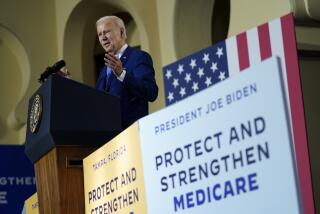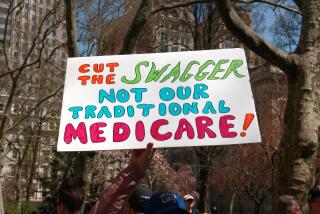The Sky Isn’t Falling on Medicare
- Share via
The biggest barrier to adding a prescription drug benefit to Medicare, as the Democrats propose, is the cultivated belief that the cost of the current system is out of control. The mantra has been, “We can’t fix it because it’s going broke.” Year after year, the forecasts of the Social Security and Medicare trustees have been used as a rationale to postpone changes that are long overdue.
But wait. Last year, the trustees made the most optimistic short-run estimate in the 35-year history of the Medicare program. After predicting four years ago that the program would run out of money in 2001, they were able to report last year that the present system can survive as is at least until 2029, indicating that the current program isn’t as much in need of cost-control reform as had been assumed.
This certainly sounds like the kind of good news that would free us to contemplate making needed coverage improvements. But cold water has been thrown on such thinking by the trustees’ estimates for 25 to 75 years from now. This long-range estimate is much more pessimistic; it predicts that Social Security expenditures--1.4% of gross domestic product in 1999--would reach 4.7% of GDP by 2075 rather than the previously estimated 2.9%.
That’s a huge jump. What accounts for it? Just one thing. Last year’s estimates projected that after 25 years, hospital insurance costs would rise at the same rate as average hourly earnings. This year’s report assumes that beyond the first 25 years, expenditures will increase at a rate equal to per-capita GDP plus 1 percentage point, with this increase continuing (and compounding) as far as the forecasts go.
Yet such an assumption, whatever its rationale, has to have a stopping place. Otherwise it becomes a mathematical certainty that eventually our entire economic output would have only one product: hospital care for the elderly.
Long before that, however, we’d all be dead, because we would have stopped producing food, clothing and shelter. Let’s get back to the real world.
Until recently, no one tried to make Medicare forecasts for more than 25 years, for the simple reason that no one can foresee how the fast-changing world of health care will look that far out. Knowing this, private health insurance plans generally limit their projections to two or three years at most, experience-adjusting premiums as they go. Medicare needs longer-range projections to establish reasonably stable contribution rates, but in the past it was thought that 25 years represented the outer limit of plausibility.
That’s still true.
How can anyone pretend to know what health care for the elderly will cost 50 or 75 years from now, let alone what portion will go to hospitalization as opposed to outpatient care or some other setting not yet envisioned? It’s as if, in voting appropriations for defense, Congress tried to anticipate how weapons systems would look and what they would cost half a century from now.
Distant-future hospital insurance forecasts are worse than worthless, because they’re bound to be misleading. We make (and continually adjust) long-range estimates for Social Security cash benefits because benefits are linked to the level of future wages. In hospital insurance, on the other hand, it is the benefit itself that is shifting. An estimate beyond 25 years creates the totally false impression that we actually know what the role of hospital care will be in 2051 or 2076.
Do we really want to be thwarted in our efforts to strengthen a uniquely successful health insurance program covering 40 million Americans by a meaningless long-range forecast? The good news in the near-term forecasts ought to be providing the basis for making many long-overdue benefit improvements--not just protection against the cost of prescription drugs, but also coverage of some of the cost of long-term care, a stop-loss provision on annual payments by patients and broader coverage of preventive care services.
The improved 25-year forecast, buttressed by a commitment to use surpluses in public funds to strengthen important programs, could help us create a Medicare program that’s ready to meet future needs--if we don’t allow the debate to be driven by a mathematically indefensible distant-future sky-is-falling projection. When did we put Chicken Little in charge of health insurance?
More to Read
Inside the business of entertainment
The Wide Shot brings you news, analysis and insights on everything from streaming wars to production — and what it all means for the future.
You may occasionally receive promotional content from the Los Angeles Times.










